In September 1909, New York City threw a party to celebrate the 300th anniversary of Henry Hudson’s discovery of the Hudson river, as well as the 100th anniversary of Robert Fulton’s introduction of steam powered boats. The Hudson-Fulton Anniversary drew thousands of visitors to the city. Two of those visitors were pioneers in the fledgling technology of aviation. Glenn Curtis and Wilbur Wright both promised to demonstrate their self-built airplanes by flying across the harbor, past the Statue of Liberty. Curtiss failed in his attempt, his underpowered plane unable to get airborne for more than a few hundred feet.
Wilbur Wright, inspired by a promised payment of $15,000 if he completed a flight in excess of 10 miles, prepared his Wright Flyer for a journey over water by rigging a canoe between the skids normally used for landing. The top of the canoe was covered with a tightly fitted canvas cover, rendering it watertight. Wright did not intend to land on water, but he wanted to be ready in case engine failure or another mechanical issue forced him to. His preparations created the first float plane ever built.
On September 29, Wright took off from Governor’s Island, flew across the harbor and around the Statue of Liberty, and returned safely to Governor’s Island. On the return leg, he flew over an ocean liner departing for Europe, the Royal Mail Steamer Lusitania, acknowledging the cheers from its passengers lining its decks. Pictures of the Wright Flyer passing the statue appeared in newspapers around the world. It was another of the many firsts in aviation accomplished by the Wright brothers; no other aviator had flown an airplane equipped to land on water. A few days later he performed another flight, one of nearly 20 miles, earning the promised prize.
Over one million New Yorkers and visitors witnessed Wilbur Wright’s orbit of the Statue of Liberty in what was essentially the world’s first floatplane. Among them was a 10-year-old son of an affluent Wall Street banker and real estate speculator. The boy’s name was Juan Trippe. Trippe was instantly smitten with all things related to flight. In less than three decades, he would be at the head of a company which dispatched flying boats to South America, Europe, Africa, and Asia, carrying cargo, mail, and passengers in luxurious surroundings. The same harbor that witnessed Wilbur Wright’s stunning achievement of 1909 would provide docking facilities for flying boats, called clippers, operated by Juan Trippe’s Pan American Airways. Here is their story.
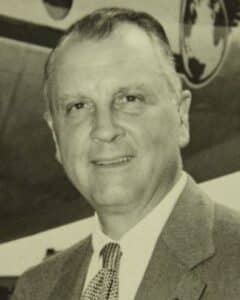
Learning His Business
Juan Terry Trippe is frequently and erroneously assumed to have been of Hispanic descent, an error encouraged by his Christian name. He was not; his name was in tribute to Juanita Terry, the wife of one of his great-uncles. He was born in Sea Bright, New Jersey, then an affluent town on the Jersey Shore in Monmouth County. His father made his living on Wall Street. Trippe went to the best schools in New York, the prestigious Hill School in Pottstown, Pennsylvania, and eventually was admitted to Yale. He also took flying lessons, learning to fly at the age of 17.
In 1917, Trippe left Yale to enlist in the United States Navy, in which he applied for flight training and the new designation of Naval Aviator. Trippe completed his flight training in June, 1918. He received a commission as an ensign in the United States Naval Reserve, though the war ended before he saw any action. Post-war, Trippe was one of the millions of men who were demobilized as the United States reduced its armed forces. He returned to Yale.
At Yale, he performed well in his classes, joined the famed secret society Skull and Bones, and continued to fly whenever he could. In 1920, the National Intercollegiate Flying Association (NIFA) was formed, with Juan Trippe elected as its first treasurer. In May 1920, NIFA held its first intercollegiate flying competition, with nine schools attending. The Yale contingent won the competition, with Juan Trippe contributing to the team’s victory, flying his own Curtiss Jenny, purchased from the US Army as war surplus.
Trippe graduated from Yale in 1921, having majored in business, and returned to New York to join his father on Wall Street. Yet he had already formulated the plans to enter business on his own, and it involved his first love, aviation. He maintained his contacts with Yale classmates and fraternity brothers, and tapped them for investment when he started his first business, a commercial air taxi service geared toward well-heeled businessmen and investors. Its success led Trippe to acquire, again with the assistance of investors from his Yale contacts, Colonial Air Transport, which operated airmail flights between New York and Boston. He then turned his attention toward the Caribbean and South America, where lucrative airmail contracts beckoned.
Creating Pan Am
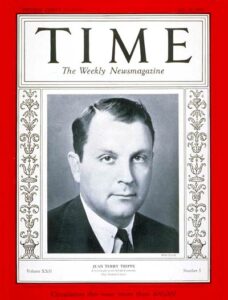
Pan American Airways began as a shell corporation, created by distinguished US Army officers to curtail the influence of a German-based airline operating in Central America. The officers, Henry “Hap” Arnold, and Carl Spaatz, considered German aviation in the region a potential threat to the Panama Canal. Their influence within the Army led that service to leverage the awarding of mail contracts. Trippe watched these developments, and in 1927, formed the Aviation Corporation of the Americas. A year previously, Trippe, with significant financial backing which included Cornelius Vanderbilt Whitney, had acquired landing rights in Havana, Cuba.
In 1927, the US Government requested bids for airmail contracts to Cuba. The Germans, Pan Am, and Trippe’s ACA all submitted bids. Pan Am won the contract to operate airmail service from Key West to Havana, but they faced two problems. One, they didn’t own the landing rights. Two, they had no airplanes. In October, ACA and Pan Am merged, along with a third company that had been created to bid on the contract, the Atlantic, Gulf and Caribbean Airways. The new company was known as ACA, with Pan Am a wholly owned subsidiary. Whitney, who was known as Sonny to his colleagues, became President of ACA. Juan Trippe became CEO of Pan American Airways. Hap Arnold and Carl Spaatz went on to further distinction in their Army and later Air Force careers.
Pan American Airways, soon known simply as Pan Am, operated its first flight using a chartered Fairchild floatplane, which took off at Key West and flew to Havana on October 19, 1927. From that inauspicious beginning, the airline grew rapidly. Trippe made numerous trips to South and Central America, buying out struggling local airlines and their routes. In those early days of commercial aviation, airmail contracts, which national governments awarded, proved the most fruitful path to profitability. Trippe traveled throughout the region to negotiate landing rights and airmail contracts. In these endeavors, he was aided by the US government, which limited competition by treating Pan Am as a de facto flag carrier for the United States.
ACA, which controlled Pan Am, became one of the most desired stocks on Wall Street in the late 1920s. As the 1930s began, Trippe used his growing prestige and influence within the aviation industry to lobby for larger, more powerful, flying boats, designed to fly longer distances while carrying more passengers. The Sikorsky S-38 flying boats Pan Am operated in the late 1920s carried only eight passengers. In 1931, Sikorsky introduced the S-40 flying boat. Trippe had lobbied hard for the development of the S-40, contributing to its design. As delivered, the S-40 could carry up to 38 passengers.
Only three S-40s were built, as Sikorsky was already developing an even larger flying boat. The three were the first aircraft to bear the designation of Clipper, with the first being named American Clipper when it was christened by Lou Hoover, the wife of President Herbert Hoover. Juan Trippe designated the new long-distance Pan Am aircraft as Clippers, a nod to the clipper ships of the past, which were known for their graceful lines and great speed.
The American Clipper made its first commercial flight on November 19, 1931 when it departed from Miami, Florida, bound for the Canal Zone. Charles Lindbergh was the lead pilot, and the aircraft’s designer, Igor Sikorsky, was aboard as a passenger. The route included stops in Cuba, Jamaica, and Colombia. That same year Aviation Corporation of America changed its name to Pan American Airways Corporation.
Even the new clippers, with their larger carrying capacity and ability to fly greater distances, were not enough for Juan Trippe. He envisioned Pan Am Clipper Service, which already stood for comfort and even luxury in the air, to cover the world. Trippe wanted Clippers flying across the Pacific to the Philippines, China, and Australia. He wanted Pan Am to cross the Atlantic, to England, and the continent, as well North Africa, South Africa, and India. In short, Juan Trippe wanted Pan Am to cover the globe. He needed ever bigger, more powerful aircraft, and he worked at acquiring them.
Heyday of the Clippers
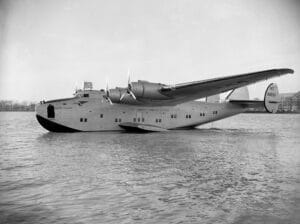
When Trippe looked at a map of the Pacific Ocean he did not see vast expanses of open water. He saw stepping stones his Clippers could use to cross the ocean from San Francisco to the Philippines, Australia, New Zealand, and China. He envisioned a flight from San Francisco Bay to Pearl Harbor in Hawaii, then to Midway Atoll. From Midway the aircraft would journey to Wake Island, then to Guam, and then a final leg to Manila. Each stop would have passengers disembark the aircraft, rest, and refresh themselves at a hotel while the airplane was refueled and prepared for the next leg of the journey. There were obstacles to his achieving such an ambitious goal. One was landing rights for each stop. His extensive government contacts quickly resolved that problem. The other was that Midway, Wake Island, and Guam lacked the necessary facilities.
There were no docking facilities, fueling facilities, hotels, restaurants, or other amenities. For Trippe to offer such services, he would have to build them. So, build them he did. In 1934 and 1935, a chartered 15,000-ton freighter, which was quite large for the day, carried construction crews and materials to the islands Pan Am would use for its Clipper service across the Pacific. At the same time, a dedicated Pan Am Terminal was constructed at the Pearl City Seaplane Base on Oahu. Pan Am manned the island stops with technicians to operate radio and navigation equipment, mechanics for the aircraft, chefs, waiters, concierges, innkeepers, housekeepers, launderers, and other workers to care for the passengers during their brief stays.
A Clipper journey was a first-class journey, both aboard the aircraft and while on the ground. It was targeted to those who would otherwise travel via the great ocean liners of the day, and both the service and the price reflected it. When service opened, a one-way trip from San Francisco to Manila cost $950, equivalent to about $20,000 in today’s money. Still, that price included overnight stays in Hawaii, Midway Atoll, Wake Island, and Guam, all meals for the six-day journey, and luxury seating in the airplane. To Pan Am and its employees, it wasn’t first class service; it was Clipper service.
The first Clipper flight across the Pacific departed San Francisco in another type of flying boat, the Martin M-130, but known to the passengers as the China Clipper. The Martin boats, designed for the trans-Pacific flights, carried up to twelve passengers. The Martin flying boats carried the service until 1939, when they were joined by Boeing 314 flying boats.
The Boeings were the pinnacle of the flying boats, and as Pan Am Clippers they were the epitome of luxury in air travel. The Boeing 314 was partitioned in the passenger compartment into five standard compartments, each of which could be configured to sleep either ten or six passengers. There was also a separate compartment known as the deluxe compartment, which included a small sofa, a love seat, a writing desk, a wardrobe, and a sink.
The passenger area also included men’s and women’s restrooms, equipped with hot and cold running water and electrical outlets. The dining room could be configured in varying table setups, depending on the number of passengers at each sitting. Tablecloths were fine linen, glassware was of cut crystal, dishes were of fine china, marked with Pan Am’s logo. Cutlery was heavy sterling silver. Meals were served by trained waiters. High tea was served from a sterling silver tea set.
The arrival of the Boeing 314 flying boats allowed Pan Am to expand transatlantic service in the late 1930s, and as it had across the Pacific, the company built facilities to accommodate their routes. A new Pan Am terminal opened in Lisbon in 1939, allowing Pan Am to connect to it from Baltimore via the city of Horta, in the Azores. In early 1939, Clipper service from Port Washington, Pan Am’s Long Island New York terminus at the time, to Marseilles, France, via Horta and Lisbon was introduced. The Clippers, which continued to fly to Lisbon during World War II during the period of US neutrality, became international symbols of the United States. The service they provided was unmatched. Yet Juan Trippe was still not satisfied.
Corporate Infighting
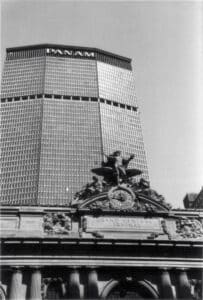
Throughout its first decade, Pan Am was run by Juan Trippe. Officially, as CEO, he was answerable to the Board of Directors. Unofficially, he answered to nobody, and the board was stocked with loyalists who did his bidding. By the late 1930s, Pan Am was the largest airline in the world, in terms of miles flown. It was one of the wealthiest and most powerful corporations in America, and Juan Trippe was one of the world’s most powerful businessmen. Airline manufacturers and designers bowed to his demands. So did the Civil Aviation Board, which actively discouraged direct competition with Pan Am by other American carriers. Yet there were cracks in the armor, among them a series of years in which low dividends were paid on shares held by investors.
In early 1939, the Board revolted, removing Trippe as CEO and installing Cornelius Vanderbilt Whitney, one of the company’s founders and one of Trippe’s closest friends, in his stead. Trippe was retained as President, but the Board enacted a new company hierarchy in which Trippe clearly reported to Whitney. Trippe was furious at the move. When Whitney took over, he relocated into Trippe’s former office, moving the then former CEO to a smaller office down the hall. Major decisions were deferred to an Executive Committee, with Whitney signing off on their decision. Trippe was, for the time being, no longer running what he viewed as his airline.
When World War II began in Europe in September, 1939, Whitney announced to the Board of Directors that he would step down as CEO, in order to concentrate his time on his diverse other activities. He recommended that the Board combine the duties of President and CEO into one office, in essence suggesting that the board reinstate Trippe as CEO. The Board complied, and Trippe reoccupied his old office in the Chrysler Building, where Pan Am kept its headquarters.
Though Whitney had, in the end, played a role in Trippe returning as CEO, he never again held Trippe’s trust or friendship. Nor did Trippe forget the role played by some members of the board, biding his time during the war years before purging several members he considered disloyal from the board. Instead, he consolidated his power and his support on the Board of Directors, abolished the Executive Committee’s decision-making authority and returned to running his airline his way.
Post War Changes
Pan Am continued to grow during the war years, expanding operations in Africa and the Middle East, in the South Pacific, and especially in South and Central America. Several of its flying boats were lost, some in accidents, some in military operations. Yet the airline continued to prosper during the war and was well-positioned in the post-war years for additional growth.
Although the flying boats attempted to return to operation briefly, their day had passed. Advances in land-based aircraft, including longer ranges, pressurization of cabins, and increased carrying capacities had rendered the flying boats obsolete. Without the flying boats, Pan Am no longer needed its global network of seaplane terminals, and most were sold to local governments or military units. Some, such as the marine terminal at New York’s LaGuardia Airport, were simply shut down. The Pan Am facility in San Francisco was absorbed into the new international airport constructed there.
The US government’s view of Pan Am shifted as well. Once recognized as America’s unofficial flag carrier, to be protected from competition, Pan Am found the government, and the Civil Aviation Board, actively urging competition. Pan Am faced competition for its South American and Caribbean routes from Braniff. Northwest Airlines challenged its domination of routes to the Orient, while United began to dominate routes to Hawaii.
But it was the transatlantic competition which irked Trippe the most. There, Pan Am found itself challenged by Trans-World Airlines, known as TWA, and its eccentric yet brilliant head, Howard Hughes. At one point, in 1962, Trippe decided to resolve the ongoing feud with Hughes by merging Pan Am with TWA, a plan which would have created a huge airline and corporation, but it ultimately fell through.
As land-based aircraft took over the overseas routes, with several refueling stops lengthening the journeys, both airlines looked for ways to attract customers. Pan Am still labeled its aircraft as Clippers, though the Clipper service of the pre-war days was considerably less plush. Dining lounges vanished, replaced by meals served to passengers in their seats. There were still sleeping berths available on some flights, dinner service still included chef-prepared meals, though the silver cutlery and full table settings vanished into the past. Still, all the airlines took pride in their amenities. In 1948, Trippe stood the industry on its ear by announcing a rate plan that boasted not of the services it provided but rather those it did not provide.
In 1948, taking advantage of the larger passenger capacities of the new land based aircraft such as the DC-4, which could carry up to 60 passengers, Trippe announced a certain number of seats per flight would be sold as tourist class, with less service and amenities, but cheaper fares. Pan Am eventually named its tourist class rates Rainbow Fares. Some flights could be designated entirely tourist class. At the same time, a higher level of service was announced for some flights, which Pan Am called President’s Class. The rest of the industry cried foul, protesting the move would initiate a price war, before all the major airlines gradually mimicked the practice.
The Jet Age
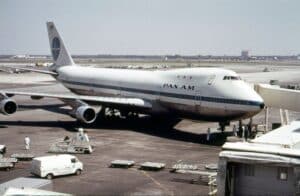
Juan Trippe and Pan Am considered purchasing the DeHavilland Comet, the first commercial jet airliner, when it was introduced in 1952. Ultimately, they passed on the aircraft. It proved to be a wise decision, as the Comet was plagued with several crashes which led to the aircraft being withdrawn and extensively redesigned. Instead, Pan Am held out for the Boeing 707, purchasing the first 20 of the four-engine jetliner, and the DC-8. Pan Am initiated jet service from New York’s Idlewild Airport, now known as JFK International, to Paris in 1958, using the new 707.
Juan Trippe was an early and avid supporter of Boeing’s widebody 747, ordering the first 25 in April 1966. Its first 747 flight took place in 1970, making Pan Am the first airline to operate widebody airliners commercially. The 747 saw multiple fare schedules per route. Its large capacity allowed several classes, with varying degrees of services, both in the air and on the ground.
Trippe also introduced numerous innovations in reservations and ticketing, commissioning IBM to develop and build the PANAMAC computer to handle its bookings, including flights, hotel reservations, ground transportation, and other services for customers. The computer occupied an entire floor of the Pan Am Building in Manhattan, the largest commercial office building in the world in 1964. Today it is the MetLife Building.
Pan Am also built its jetport at JFK International, an immediately iconic structure totally dedicated to jet travel and the then-new jet age.
Juan Trippe retired as President and CEO of Pan Am in 1968, having served as the de facto head of the airline since its founding, other than the eight months when he was temporarily replaced by Sonny Whitney. That same year the power and prestige of the airline were reflected by the prominent use of the Pan Am space planes depicted in the motion picture 2001: A Space Odyssey. Unfortunately, the prediction of Pan Am continuing to thrive in the 21st century proved to be too optimistic.
In retirement, Trippe continued to attend board meetings for the airline and maintained an office in the Pan Am Building. He left behind a company that was widely considered the world’s premier airline, as well as the International Hotels Corporation, which he founded in 1946 to increase business activity in key cities in South America. A project first proposed by President Roosevelt before World War II, Trippe came to believe that increased business activity in South America would create more business for Pan Am. Today, that company lives on as Intercontinental Hotels and Resorts.
Pan American World Airways does not. Beginning in the late 1970s and during the remainder of the 20th Century, the company suffered numerous difficulties. Deregulation, terrorist bombings, heavy competition, rising fuel costs, and an aging fleet were all contributing factors in the airline’s demise. Pan Am ceased operations in December 1991. There have been attempts to revive the brand, though to date all have failed.
Between Wilbur Wright’s 1909 flight around the Statue of Liberty and Juan Trippe’s retirement, a mere 59 years elapsed. In 1970, two years after Juan Trippe’s retirement, Pan Am flew 16.4 million passenger miles. Under his guidance, Pan Am grew to operate scheduled flights to all six continents of the globe. It never, in Trippe’s lifetime, developed any domestic routes in the United States, one of the factors which contributed to its collapse in the 1980s. But it became and remained the standard by which all other international airlines were judged, especially in the early days of the jet age.
Juan Trippe did not live to see the demise of his beloved airline. He suffered a stroke in 1980, which ended his days of going to his Manhattan office. Another stroke in April 1981 led to his death.
In 1985, President Ronald Reagan posthumously awarded Juan Trippe the Presidential Medal of Freedom, the highest civilian award in the United States. He is regarded as one of the great pioneers of commercial aviation in the world, and one of the greatest entrepreneurs of the 20th century.



